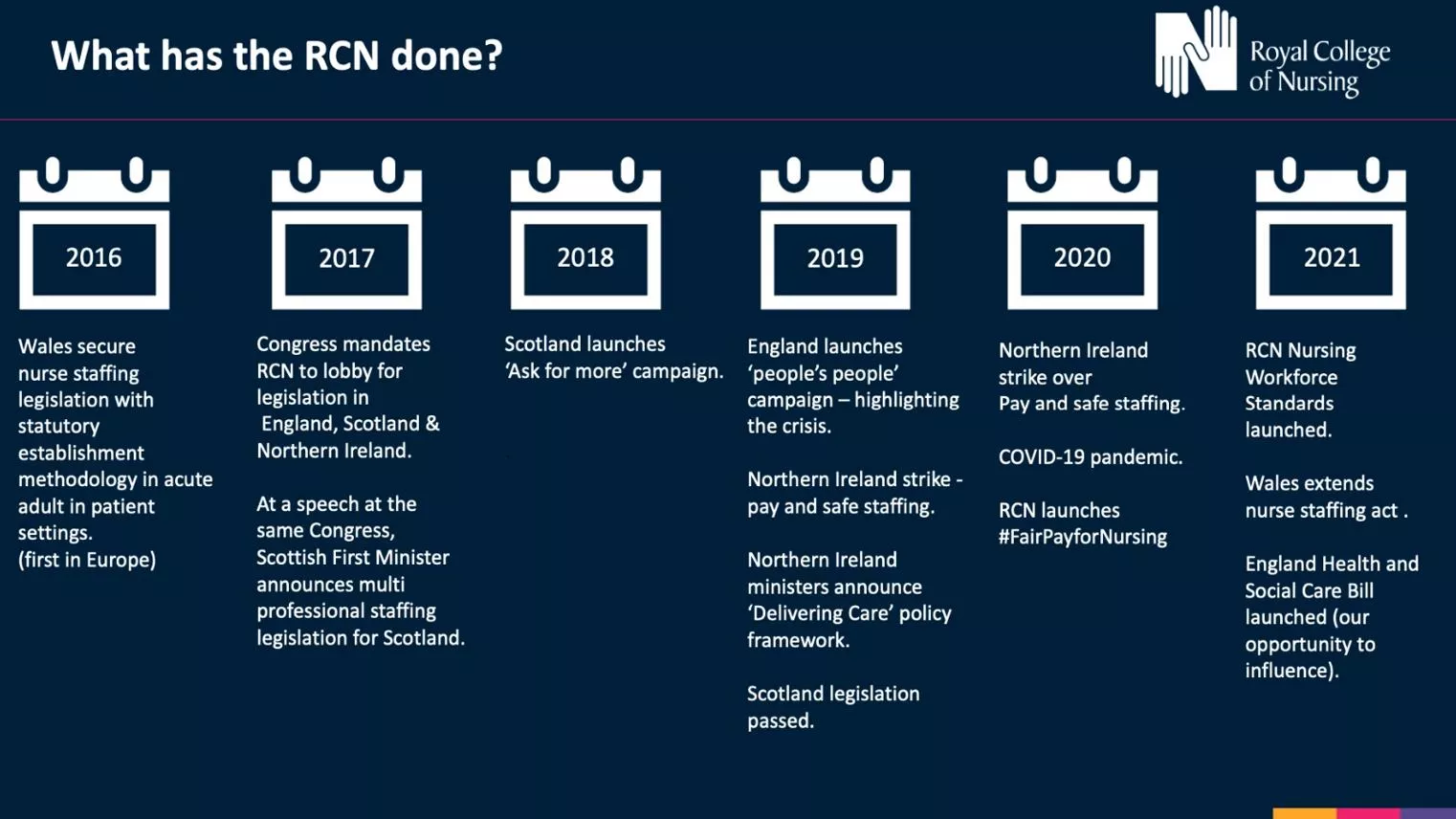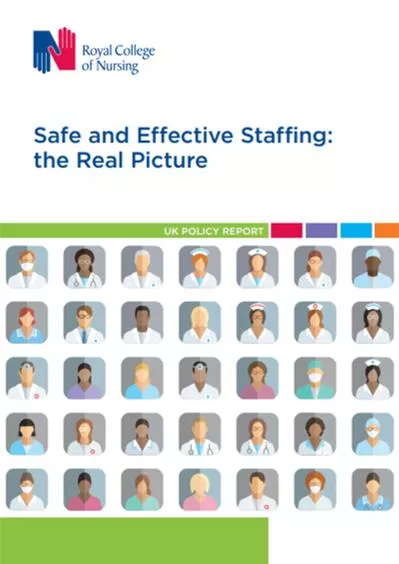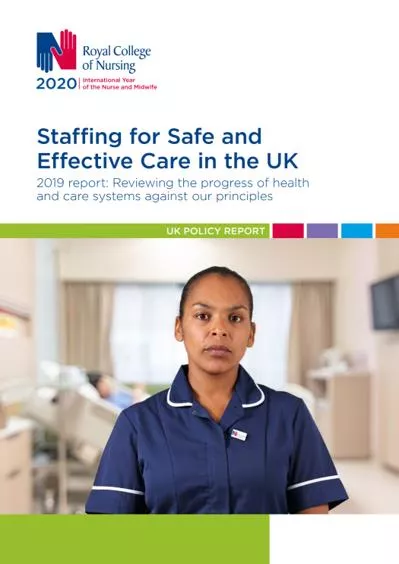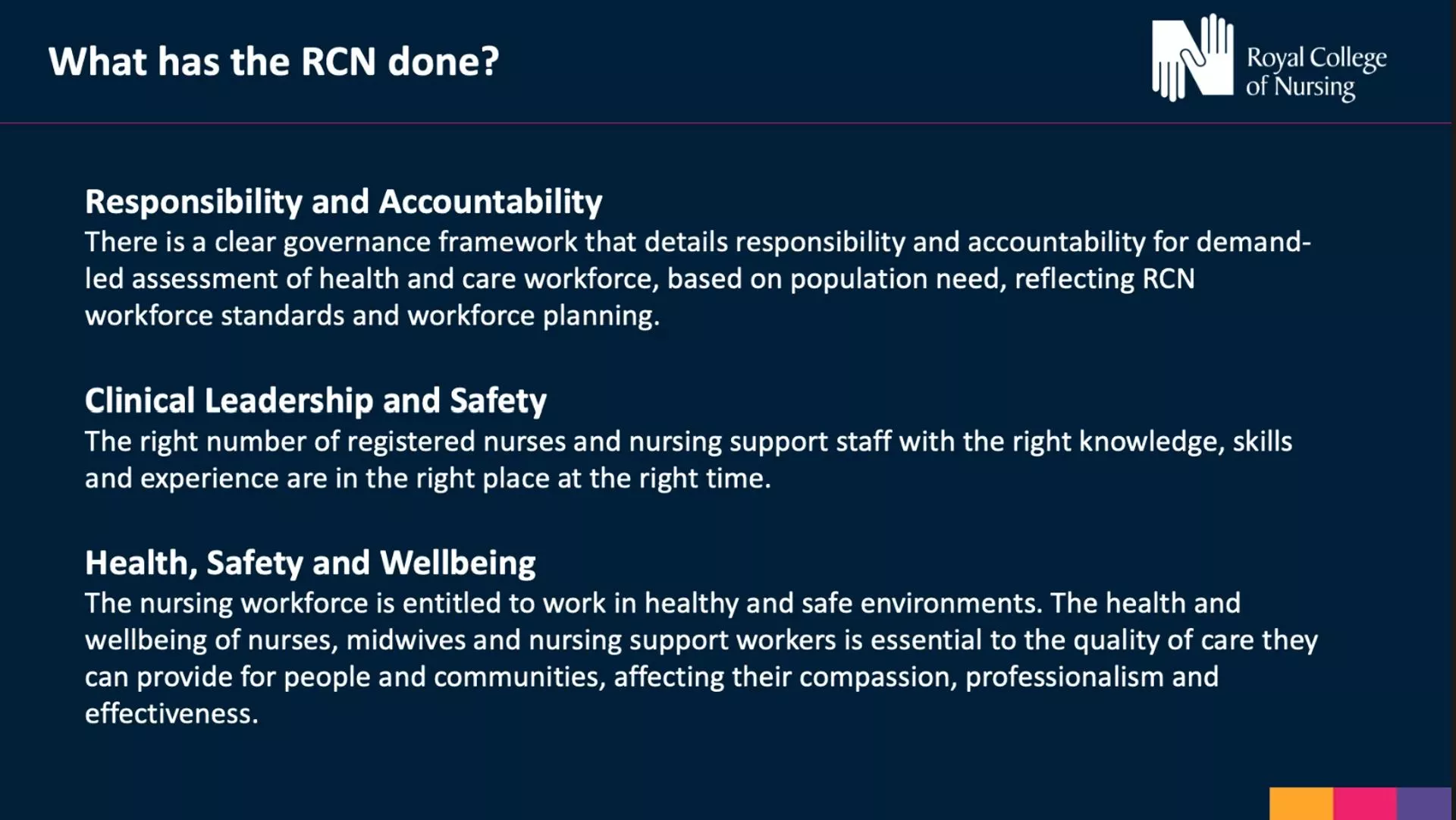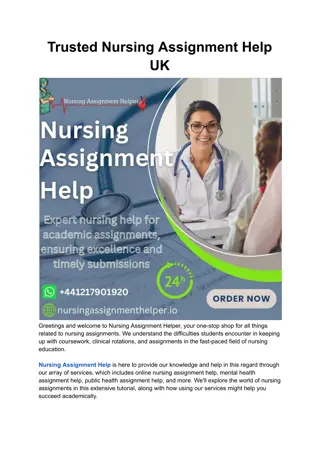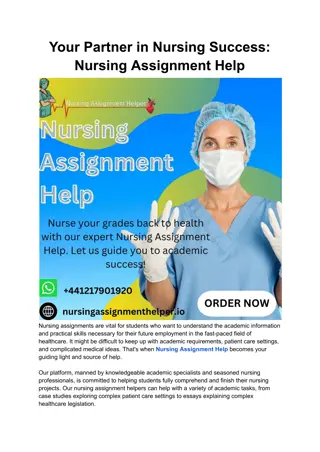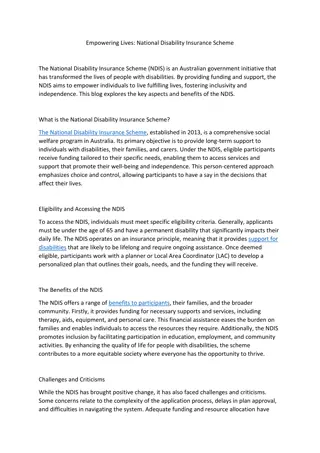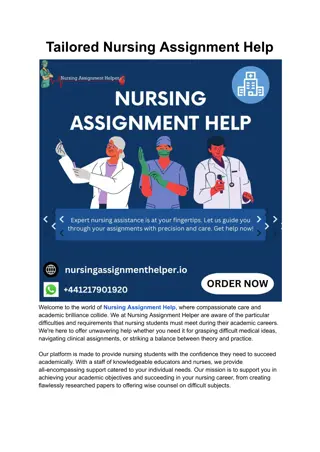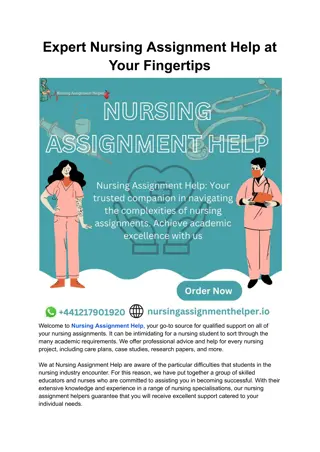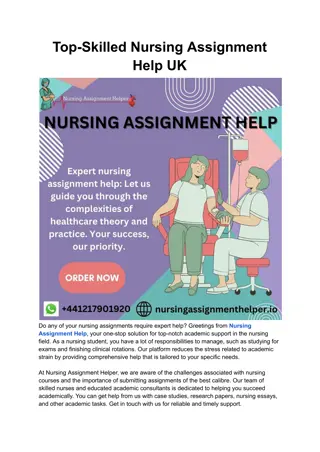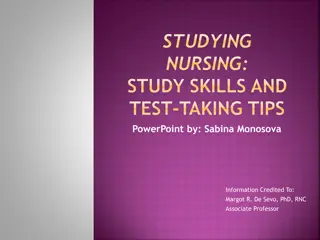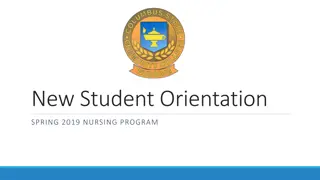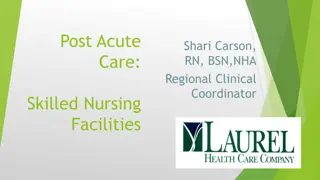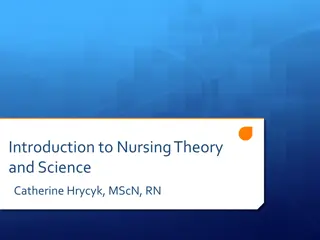Nursing Workforce Standards Presentation
Slide deck introducing and explaining the Royal College of Nursing's national standards for safe and effective care, including key themes like responsibility, accountability, clinical leadership, safety, health, safety, and wellbeing. The presentation includes visuals and resources for a comprehensive understanding of the standards.
Download Presentation

Please find below an Image/Link to download the presentation.
The content on the website is provided AS IS for your information and personal use only. It may not be sold, licensed, or shared on other websites without obtaining consent from the author.If you encounter any issues during the download, it is possible that the publisher has removed the file from their server.
You are allowed to download the files provided on this website for personal or commercial use, subject to the condition that they are used lawfully. All files are the property of their respective owners.
The content on the website is provided AS IS for your information and personal use only. It may not be sold, licensed, or shared on other websites without obtaining consent from the author.
E N D
Presentation Transcript
Nursing Workforce Standards Slide Deck This slide deck is designed for you to choose your own slides present. You can use to either deliver a stand-alone presentation on the standards or to add slides to existing presentations. The first section is designed to introduce the standards and the wider Staffing for safe and effective Care campaign. The latter slides can be used with these to close a presentation and includes links to the digital resources. Slide 6 includes a poster pdf of the standards and is could be used as a stand- alone slide or in conjunction with slide 5. The setting specific slides can be selected according to need and audience. Please refer to the slide deck regularly on the website as additions and changes will be made as required/ resources developed.
NURSING WORKFORCE STANDARDS Supporting a safe and effective nursing workforce
Nursing Workforce Standards Chair of the RCN's Professional Nursing Committee, Rachel Hollis, introduces the College's first national standards for delivery of safe and effective care. Watch the video
About the Standards The Standards set out the position of the Royal College of Nursing based on evidence and professional expert consensus. They are important for our work as both a professional body and as the largest trade union for nurses. The standards apply across all areas of nursing and all health and care sectors across the United Kingdom. The Standards are designed to support a safe and effective nursing workforce alongside each nation s legislation. The 14 Standards are grouped into 3 key themes: Responsibility and Accountability 4 standards Clinical Leadership and Safety - 6 standards Health, Safety and Wellbeing - 4 standards
Importance of nurse leadership Standard 5 Standard 6 Examples Nurse leaders receive dedicated workforce planning time Each nursing service has a registered nurse lead 6a Should be 100% supervisory (i.e. not planned to be in the numbers) if not needs to be a documented exception and reported to board. 6b list of what this resource and time is for. 6c Role within leadership team needs to be included in job descriptions. 5a - Each team & service (e.g. Ward/ Community team/ Nursing Home) should have a registered nurse lead. 5b If it is a wider MDT team and not managed by a RN then there must be a clear line to nursing leadership.
Nursing Workforce Standards Legislation Escalation guidance Stanrds Pay Staffing for Safe and Effective Care
They are part of a suite of resources to drive standards towards staffing for safe and effective care . Where the Standards are not met, action can be taken in line with RCN guidance on 'Raising and Escalating Concerns (June 2023) View the publication
Country specific slides This section is currently in development and will be uploaded soon
Nursing within a specialism Clinical Leadership Education & research Standard 7 : Practice development including CPD and clinical supervision Standard 8: Uplift Standard 8b: Sets out what must be considered Standard 8c: Professional judgement considerations Standard 10: CPD appropriately prepared and work within scope of practice Standard 5a: Registered nurse lead for nursing teams Standard 5b: Link to nursing leadership is essential (e.g. if part of wider MDT/rota) Standard 6: Time to lead. Admin support Standards 6a&b: Leadership parts of job plan should be supervisory and not included in the numbers Standard 6c: Role within leadership team needs to be included in job descriptions Standard 2: Establishments meet demand, are reviewed and reported to board who are accountable Standard 2b: Workforce data review at least monthly Standard 2f: Double counting, for example, if on a multi-professional rota should not also be counted in nursing numbers for that clinical area Standard 2h: Students are supernumerary. Standard 9: Substantive 80%+
Executive Level Nurses Standard 1 Examples Senior nurses set nurse staffing levels and executive boards are accountable 1i -Each organisation should have a board- approved risk management and escalation process in place to enable real-time nurse staffing risk escalation and mitigation with clear and transparent procedure to address severe and recurrent risks. 1a There should be an executive level nurse. 1f - In setting the nursing establishment workforce planning and decision making should be underpinned by knowledge and experience. The responsibility for setting nursing establishments remains with the executive nurse. 1b If not (e.g. small organisation/ company) this should be a documented exception that is documented, reported and reviewed. This can then be supported or challenged by commissioners and regulators. professional nursing 1c Whole board are accountable. 1g - Nurse leaders are integral to contracting and commissioning care in order to distinguish between nursing specific workload and that of the wider multi-professional workforce. 1d - The nursing workforce establishment should be determined by the demand for services and the need to provide safe and effective care. 1h - Decisions on nurse staffing must be recorded. Discussions must detail the workforce requirements of the organisation/service in order to provide staffing for safe and effective care. 1e. Setting the nursing workforce establishment should explicitly inform the organisation s financial planning and be funded by revenue allocation rather than fitting a prescribed financial envelope.
Executive Level Nurses Standard 2 Examples Nurse staffing levels are based on service demand and user need patient-dependency/acuity workload tools clinical quality indicators nationally agreed standards peer reviewed published evidence benchmark data from matched comparators who can evidence the delivery of high-quality person centred services and/or data linkage to care quality indicators. 2g. Staff who support the workforce, such as clerical, housekeeping and catering staff, should not be considered within nursing workforce numbers when determining the nursing establishment to meet clinical need. 2a The nursing workforce will be a standing item for discussion at the board or accountable body for decision making in any organisation providing nursing services. 2b Workforce data should be reviewed at least monthly and redflags such as high rates of sickness or turnover investigated with transparency. 2h. All nursing students must be supernumerary when in training. 2c A framework should be in place that enables regular review and decisions about service provision and workforce resourcing. 2e - Once any review is completed, an action plan should be created to address any issues identified. 2d - A continuous quality improvement approach to staffing should be taken. A triangulated approach is required and will include: 2f - Where there are nurses rostered within a multi-professional workforce rota, they cannot be counted twice. professional judgement
Executive Level Nurse examples A Director of Nursing presents the standards to the executive board particularly highlighting Standard 1c-i & 2a. With the nursing workforce now a standing item this is then used to work through the various standards highlighting where compliance exists and how to make step changes towards achieving this where there are gaps. Examples: Standard 6 set s out the supervisory role of ward/team leaders, the DoN has worked with the nursing leadership team and determined currently this occurs on average 33% of the time. The amount of additional wte band 5/6 is calculated to initially get this to 50% within 1 year, 75% by year 2 and 100% by year 3. A business case can then be developed. Standard 8 sets out what should be included to calculate uplift. 8a,b and c are used to evidence base a review and proposed new uplift % for the trust. Standard 9 is used to instigate reporting every time substantive nursing workforce falls below 80%. The DoN can use the regular board agenda item to raise this which is a regular occurrence as agency/ bank use often above 20%. This is used to prompt a discussion regarding what can be done to both elevate and mitigate the problem as well as ensure risk recognised and recorded. The internal quality assurance framework can also be reviewed and adjusted to incorporate the standards as part of the assessment process and to evidence base change. This is useful to prepare for regulator visits ect.
Independent sector example An Independent sector Chief Nurse is not currently executive level and reports to the Medical Director. Whilst on the senior management team they do not have a seat on the board. The standards are used to highlight the need to an executive level nurse and if not 1b states that this should be a documented exception. This is used to start the conversation, challenge the corporate board and also 1c sets out that the whole board is accountable for nursing workforce. Standard 2a also states that nursing establishment should be a standing item on each board meeting. All of these factors together make a strong case for the Chief Nurse to become an executive level post.
Care Home examples A care home with nursing is looking to recruit a registered manager that is not a registrant. Standard 5a can be used to argue against this as each clinical team or service that provides nursing care will have a registered nurse lead . There is a high reliance on agency and temporary staff particularly on night shifts. Standard 9, states that when the substantive staff ratio falls below 80% this should be reported (to the corporate board, likely management board in smaller homes). 9a includes ensuring continuity of care. One organisation suggested that they stopped having an RN overnight and substituted with a NSW and an on- call RN available by phone. There are lots of reasons why this could be challenged, and the standards add to this: Standard 1 (accountability: board level, in this setting likely to include owners in smaller establishments) 1a includes responsibility to those who contract or commission services. Standards 2 all and b,c very useful here. Insufficient time for CPD, struggle to ensure statutory & mandatory training. Standard 10 sets out what is required and Standard 8 covers ensuring uplift in establishments is sufficient.
Care Home setting The Nursing Workforce Standards are applicable to this setting and will be a very useful tool to drive change. There are 14 standards and all have descriptors e.g. 1a,b,c Standard 1 Standard 5 Examples Senior nurses set nurse staffing levels and executive boards are accountable Each nursing service has a registered nurse lead 1a There should be an executive level nurse. 5a - Each team & service (e.g. Nursing Home/ Care Home with nursing) should have a registered nurse lead (standard 6 sets out dedicated time & resources for this). 1b If not (e.g. small organisation/ company) this should be a documented exception that is documented, reported and reviewed. This can then be supported or challenged by commissioners and regulators. 5b If it is a wider MDT team and not managed by a RN then there must be a clear line to nursing leadership. 1c Whole board are accountable.
Care Home setting Standard 10 Examples Nursing staff are prepared and work within their scope of practice 10c - For staff who are lone workers, there must be clear access to advice, supervision and support at all times as well as compliance with necessary health and safety requirements. 10a - This includes access to CPD, education, support and development to ensure the nursing workforce has the knowledge, skills and competencies required to deliver evidence based, safe, person-centred care that is of high- quality. 10b - The registered nurse lead will ensure that: individuals workforce, including those in management roles, are allocated a period of supernumerary induction / preceptorship individuals with no previous experience should have a preceptorship period which includes structured induction and close supervision until specialty competence and confidence are achieved for more senior/experienced staff taking on additional or different roles, a preceptorship period is still needed until competence and confidence are achieved. appointed to the nursing 10d - Fostering leadership capability is integral to all members of the nursing workforce throughout their career psychologically safe culture and strengthen the nursing voice. As a minimum this needs to include: to embed a safeguarding mental capacity consent record keeping basic life support competency frameworks specific to the area of specialty the principles of accountability and delegation raising concerns health and safety related training including moving and handling, infection prevention and control and fire training.
Advanced Nursing Practice example An advanced clinical practitioner (nurse) is working on a multi-professional rota on the medical take, based mainly on the Acute Medical Unit. There are nursing staffing issues on AMU today due to sickness and vacancies and the Matron said in passing that they will need to also count you in the numbers today on AMU because if not the dashboard will be red. Standard 2f states that this shouldn t happen and that a nurse can t be counted twice. This includes those that are rostered on any multi-professional rota.
Advanced Nursing Practice Education & research pillars Leadership pillars Clinical pillars Standards 2 Establishments meet demand, are reviewed & reported to board who are accountable Standard 5a Registered Nurse Lead for nursing teams. b - link to nursing leadership essential e.g. if part of wider MDT team/ rota. Standard 7 Practice development including CPD and Clinical Supervision 2b workforce data review, at least monthly 2f Double counting: for example if on a multi-prof rota shouldn t also be counted in nursing numbers for that clinical area. 2h Students are supernumerary Standard 8 Uplift 8b set s out what must be considered 8c professional judgement Standard 6 Time to lead 6a,b Leadership parts of job plan should be supervisory & not in the numbers. 6c Role within leadership team needs to be included in job descriptions. Standard 10 CPD appropriately prepared and work within scope of practice Standard 9 - Substantive 80%+
Justice and Forensic Settings Police custody Prison Court Sexual Assault Referral Centres Substance use services Low, medium and high secure forensic mental health services Community forensic mental health care
Justice and Forensic Settings Standards 1 - 4 Examples Responsibility and Accountability Often independent providers in situ, sometimes without strong, audible nurse leadership, which impacts on the way in which the nursing voice is heard In many areas, the medical model prevails which can impact on nursing support and development (e.g. clinical supervision) Recruitment is a significant issue with poor understanding of the area by the wider nursing community, delays in security clearances and the provision of safe, effective workplaces for staff (e.g. converted cells as clinic rooms) Business continuity plans need to take account of things not normally associated with healthcare including riots, civil unrest, security lockdowns and high levels of aggression Some independent providers do not have equitable NHS T&C and there are sometimes no recognised relationships with trade unions
Justice and Forensic Settings Standards 5 - 10 Examples Clinical Leadership and Safety Not always a registered nurse leader in justice settings The nursing voice competes with the medical and security discourses. Strong nursing leadership is crucial Chronic staff shortages lead to less time for senior nurses to focus on leading and managing the team Models of service provision do not hold practice development in high esteem focus on meeting immediate clinical need Workforce planning does not take account of the physical environment long distances across prisons and patients in small, confined spaces (cells) Reliance on temporary staff, who become permanently temporary given constraints of access (security clearance) Needs to be recognition that the preparation for the nursing role in these settings includes areas not traditionally related to healthcare (security, jailcraft , conditioning etc)
Justice and Forensic Settings Standards 11 - 14 Examples Health, Safety and Wellbeing Rostering patterns can be entrenched in custom and practice, particularly with regards to long days and nights Secure healthcare settings can be hidden from view and staff can feel invisible from the nursing community. Can feel professionally unsupported when raising concerns. Particularly difficult when caring for mariginalised population about whom the public can be very negative Physical working environment can be challenging old buildings, small spaces, poor facilities for staff Patient care and staff care are sometimes competing priorities. Self care needs to be role modelled by leaders
Support for the Standards Andrea Sutcliffe, Chief Executive and Registrar of the NMC: This is useful guidance from the RCN that nurses and their employers can use to assist them navigate the operational challenges they face to deliver the safe, kind and effective care our communities need. Saffron Cordery, Deputy chief executive of NHS Providers: We agree with the RCN that enough staff need to be recruited and retained not only to address existing workforce gaps, but to help build vital flexibility into the system to protect staff wellbeing and development. NHS bodies must recognise the specific workforce needs that have emerged or been reemphasised this past year, to ensure that the correct lessons are learnt. Rebecca Smith, Managing Director of NHS Employers: Employers will welcome these workforce standards for nursing. Nurses are at the heart of our NHS teams, and these standards will help to ensure that is recognised, so that nursing staff can continue to provide safe and effective care to patients and communities, while also ensuring they are properly cared for and supported themselves.
How are the Standards presented? Online resource : www.rcn.org.uk/nursingworkforcestandards FAQs Additional resources to support the standards Links to psychological escalation guidance Links to legislation and professional guidance where it exists. The RCN vision Every member of the nursing workforce uses the Standards in part or in whole to support them as an individual or on behalf of a nursing workforce. The Standards will become as well known as the NMC Code. The Standards are used to uphold safe and effective staffing for the nursing workforce UK-wide.
Any questions ?
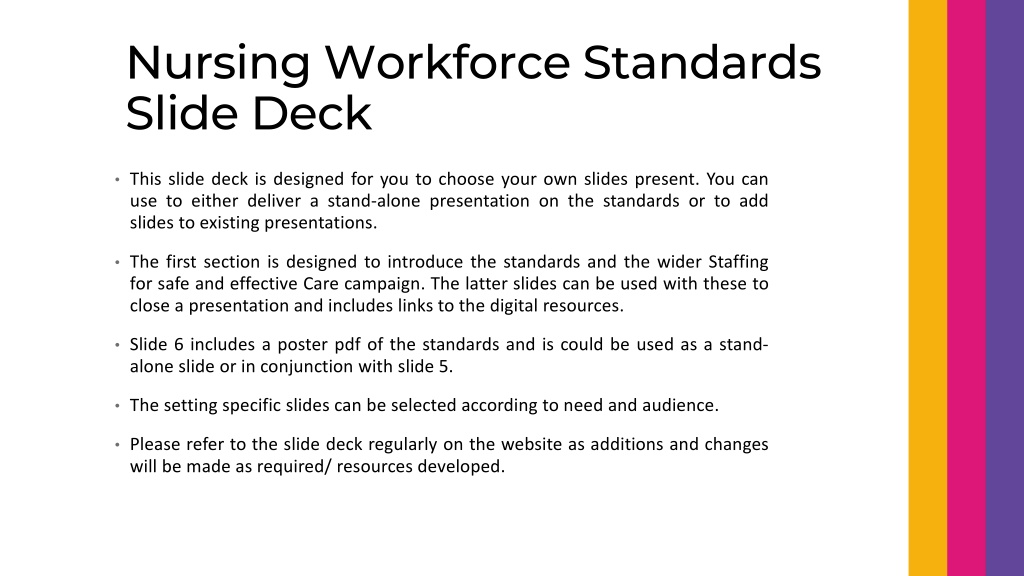




 undefined
undefined




